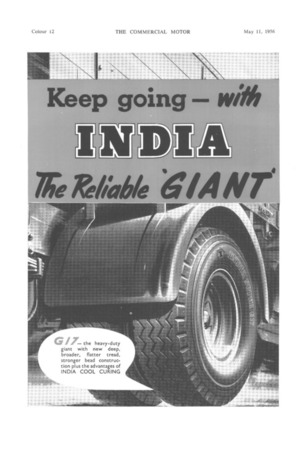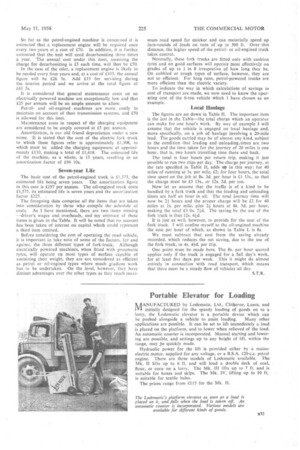Keep going— wait
Page 84

Page 85

If you've noticed an error in this article please click here to report it so we can fix it.
[twit Nicli
ido ARC
segikkkemAir
So far as the petrol-engined machine is concerned it is estimated that a replacement engine will be required once every two years at a cost of £70. In addition, it is further estimated that the unit will need decarbonizing three times a year. The annual cost under this item, assuming the charge for decarbonizing is £5 each time, will thus be £50.
In the case of the oiler, a replacement engine is likely to be needed every four years and, at a cost of £105, the annual figure will be £26 5s, Add £15 for servicing during the interim period and we arrive at the total figure of £41 5s,
It is considered that general maintenance costs on an electrically powered machine are exceptionally low and that £25 per annum will be an ample amount to allow.
Petroland oil-engined machines are more costly to maintain on account of their transmission systems, and £50 is allowed for this item.
Maintenance costs in respect of the charging equipment are considered to be amply covered at £5 per annum.
Amortization, is our old friend depreciation under a new name. It is stated that the cost of the electric fork truck to which these figures refer is approximately £1,308, to which must be added the charging equipment at approximately £110, making a total Of £1,418. The estimated life of the machine, as a whole, is .15 years, resulting in an amortization -factor of £94 10s.
Seven-year Life
The basic cost of the petrol-engined truck is £1,375, the estimated life being seven years. The amortization figure in this case is £197 per annum. The oil-engined truck costs £1,575, its estimated life is seven years and the amortization factor £225. , The foregoing data comprise all the items that are taken into consideration by those who compile the schedule of costs. As I have mentioned, there are two items missing --driver's wages and overheads, and my estimate of these items is given in the Table. It will be noted that no account has been taken of interest on capital which could represent a third item omitted.
Before considering the cost of operating the road vehicle, it is important to take note of some of the factors, for and against, the three different types of fork-truck. Although electrically powered machines, when fitted with pneumatic tyres, will operate on most types of surface capable of sustaining their weight, they are not considered as efficient as petrol or oil-engined types where much gradient work has to be undertaken. On the level, however, they have distinct advantages over the other types as they reach maxi
mum road speed far Quicker and can materially speed up turn-rounds of loads on runs of up to 300 ft. Over -this distance, the higher speed of the petrolor oil-engined truck takes contral.
Normally, these fork trucks are fitted only with cushion tyres and on good surfaces will operate most effectively on grades of up to 1 in 8 irrespective of how long they be. On cobbled or rough types of surface, however, they are not so efficient. For long runs, petrol-powered trucks are more efficient than the electric variety.
• To indicate the way in which calculations of savings in cost of transport are made, we now need to know the operating cost of the 6-ton vehicle which I have chosen as an example.
Local Haulage The figures are set down in Table 11. The important item is the last in the Table—the total charge which an operator can make for one hour's work. By way of example I will assume that the vehicle is engaged on local haulage and, more specifically, on a job of haulage involving a 20-mile lead. The goods carried may be of almost any kind, subject to the condition that loading and unloadingAimes are two hours and the time taken for the journey of 20 miles is one hour, that is, two hours travelling time there and back.
The total is four hours per return trip, making it just possible to run two trips per day. The charge per journey, at the rate specified in Table II, adds up in this Isfayi for 40 miles of running at Is. per mile, £2; for four hours, the total time spent on the job at.8s. 3d. per hour is £1 13s., so that the charge must be £3 13s., or 12s. 2d. per, ton.
Now let us assume that the traffic is of a kind to be handled by a fork truck and that the loading and unloading times are half an hour in all. The total journey time will now. be 21 hours and the proper charge will be £2 for 40 miles at Is. per mile, plus 24 hours at 8s. 3d. per hour, making the total £3 Os. 71d. Th saving by the use of the fork truck is thus 12s. 444:1.
It is just as well, however, to provide for the cost of the fork truck. I will confine myself to the oil-engined machine the cost per hour of which, as shown in Table I, is 8s.
We must subtract that cost from the saving already recorded, which reduces the net saving, due to the use of the fork truck, to 4s. 44(1. per trip.
One point must be made here. The 8s. per hour quoted applies only if the truck is engaged for a full day's work. for af least five days per week. This it might do almost entirely in connection with road transport, which means that there must be a steady flow of vehicles all day.




























































































































